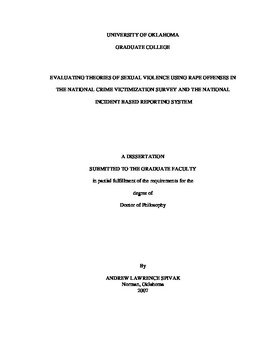| dc.contributor.advisor | Damphousse, Kelly, | en_US |
| dc.contributor.advisor | St. John, Craig, | en_US |
| dc.contributor.author | Spivak, Andrew Lawrence. | en_US |
| dc.date.accessioned | 2013-08-16T12:21:02Z | |
| dc.date.available | 2013-08-16T12:21:02Z | |
| dc.date.issued | 2007 | en_US |
| dc.identifier.uri | https://hdl.handle.net/11244/1308 | |
| dc.description.abstract | Indiscriminate selection suggests, as some feminist theorists have posited, that the young age distribution is due to routine activities and offenders will select victims only in accordance with convenience and opportunity, with minimal regard for age. A paradigm of deliberate targeting for youth predicts that offenders may prefer younger female victims even when controlling for proximity and access. The analyses presented here examine the difference in age distribution of victims and the discord between victim and offender ages in the cases of different victim-offender relationships (stranger, acquaintance, intimate partner, friend/family) and other measures of routine activities. Data on rape offense incidents from the 1992-2004 National Crime Victimization Survey (N=557) and the National Incident Based Reporting System 2004 (N=13,510) revealed support for both perspectives. While victim-offender relationship and other demographic and situational predictors strongly influence the age distribution of selected victims, the victimization risk associated with younger women cannot be entirely explained with the routine activity measures available. In the rape incident datasets, victim age distributions were similar across levels of victim offender relationship after controls, and in a dataset of robbery incidents, victims' youth predicted likelihood of being raped when relationship-based opportunity (all stranger offenders) was controlled. While feminist and evolutionary predictions both receive a degree of support, results tend to support selection for younger victims, controlling for routine activity measures such as victim-offender relationship. Opportunities for a post-classical criminological interpretation are discussed. | en_US |
| dc.description.abstract | This study contributes to the discussion of feminist, evolutionary, routine activity, and social control theory explanations for the age distribution of rape victims by evaluating the predictive value of demographic factors about victims and offenders that predict the age distribution of female rape victims. The debate between feminist and sociobiological theorists has been contentious and bitter, and has resulted in the polarization of ideas related to whether offenders' motives are sexual, nonsexual, or both. This study examines these theoretical standpoints in criminological perspective, and uses national victim survey and official reporting data to determine the extent to which rapists preferentially select victims based on youth and attractiveness, or whether victim selection is more indiscriminate and based on proximity and convenience. | en_US |
| dc.format.extent | xiv, 162 leaves : | en_US |
| dc.subject | Rape Psychological aspects. | en_US |
| dc.subject | Rapists. | en_US |
| dc.subject | Psychology, Social. | en_US |
| dc.subject | Rape. | en_US |
| dc.subject | Rape victims. | en_US |
| dc.subject | Rapists Psychology. | en_US |
| dc.subject | Rape victims Psychology. | en_US |
| dc.subject | Psychology, Clinical. | en_US |
| dc.subject | Sociology, Criminology and Penology. | en_US |
| dc.title | Evaluating theories of sexual violence using rape offenses in the National Crime Victimization Survey and the National Incident Based Reporting System. | en_US |
| dc.type | Thesis | en_US |
| dc.thesis.degree | Ph.D. | en_US |
| dc.thesis.degreeDiscipline | Department of Sociology | en_US |
| dc.note | Advisers: Kelly Damphousse; Craig St. John. | en_US |
| dc.note | Source: Dissertation Abstracts International, Volume: 69-01, Section: A, page: 0389. | en_US |
| ou.identifier | (UMI)AAI3291941 | en_US |
| ou.group | College of Arts and Sciences::Department of Sociology | |
